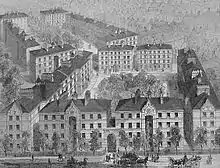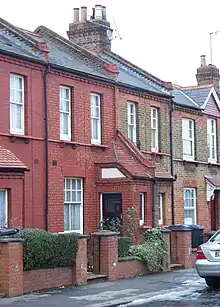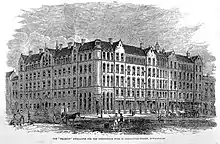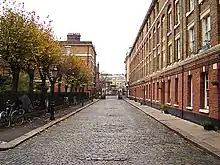
Model dwellings were buildings or estates constructed, mostly during the Victorian era, along philanthropic lines to provide decent living accommodation for the working class. They were typically erected by private model dwellings companies and usually with the aim of making a return on investment, hence the description of the movement as "five per cent philanthropy."[1] As such they were forerunners of modern-day municipal housing.
This is a list of still-standing model dwellings, organised by builder. Most of these companies are now defunct; a few, such as the Peabody Trust are still operating and building new accommodation, and others have been subsumed by larger firms. This list covers urban development on the principle of "five per cent philanthropy"; for communities built to house workers for a particular trade or employer, see model village or company town.
Artizans, Labourers & General Dwellings Company

The Artizans' Company (ALGDC) was established in 1867 by William Austin, becoming one of the largest of the model dwellings companies in the late Victorian era. It was best known for its large, low-rise, suburban estates in London. It was later subsumed into Sun Life Financial.
| Name of dwelling | Location | Date of construction |
|---|---|---|
| Noel Park[2] | Wood Green, London | 1882–1929 |
| Pinnerwood Park[3] | Pinner, London | 1932–1935 |
| Queen's Park[4] | Kilburn, London | 1874–1881 |
| Shaftesbury Park[5] | Battersea, London | 1872–1877 |
| Leigham Court[6] | Streatham, London | 1889–1928 |
| Crawford Buildings[7] | Marylebone, London | 1893 |
| Wendover Court (formerly East Street Buildings)[8] | Marylebone, London | 1890-1891 |
| Seymour Buildings[9] | Marylebone, London | 1889 |
Chester Cottage Improvement Company
The Chester Cottage Improvement Company was founded in 1892,[10] and was a particular concern of the Duke of Westminster.[11]
| Name of dwelling | Location | Date of construction |
|---|---|---|
| Priory Place[12][13][14] | Chester, Cheshire | 1898 |
East End Dwellings Company
The EEDC was founded by Samuel Barnett and others in 1882 in order to provide particularly for the area that is now the London Borough of Tower Hamlets.
| Name of dwelling | Location | Date of construction |
|---|---|---|
| Museum House[15] | Burnham Road, Bethnal Green, London | 1888 |
| Dunstan Houses[16] | Stepney Green, London | 1899 |
| Thornhill Houses[17] | Thornhill Road, Barnsbury, London | 1902 |
| Whidborne Buildings[18] | Kings Cross, London | 1890s |
Edinburgh Co-Operative Building Company
The Edinburgh Co-Operative Building Company (ECBC) was founded by a group of stonemasons in Edinburgh in 1861. By 1872 they had built nearly 1,000 houses in six parts of Edinburgh and Leith,[19] commonly known as colony houses.
| Name of dwelling | Location | Date of construction |
|---|---|---|
| Abbeyhill Colonies[20] | London Road, Abbeyhill, Edinburgh | |
| Dalry Colonies[21] | Dalry, Edinburgh | 1868–1870 |
| Shaftesbury Park | Shandon, Edinburgh | 1883–1904 |
| Stockbridge Colonies[21] | Glenogle Road, Stockbridge, Edinburgh | 1861–1867 |
Four Per Cent Industrial Dwellings Company

| Name of dwelling | Location | Date of construction |
|---|---|---|
| Stepney Green Court[22] | Stepney Green, London | 1896 |
| Navarino Mansions[23] | Dalston Lane, Hackney | 1903-5 |
| Mocatta House[24] | Brady Street, Whitechapel, London | 1905 |
| Evelina Mansions[25] | Camberwell, London | 1900 |
| Rebecca House[26] | Mile End, London | 1933 |
Improved Industrial Dwellings Company
The Improved Industrial Dwellings Company (IIDC) was founded by the stationer (and later Lord Mayor) Sir Sydney Waterlow in 1863.
| Name of dwelling | Location | Date of construction |
|---|---|---|
| Asmun's Hill cottages | Hampstead Garden Suburb, London | 1909 |
| Clarendon Buildings[27] | Balderton Street, Westminster, London | 1872 |
| Cobden Buildings[28] | King's Cross Road, London | 1865 |
| Cromwell Building[29] | Redcross Way, Camberwell, London | 1864 |
| Derby Buildings[30] | Wicklow Street, Camden Town, London | c.1865 |
| Grosvenor Estate[31] (now operated by Peabody Trust) | Brownhart Gardens, Mayfair, London | 1886–1982 |
| Leopold Buildings[32] | Bakers Rents, Poplar, London | 1872 |
| Stanley Buildings[33] | Midland Road, Camden Town, London | 1865 |
| Tower Buildings[34] | Brewhouse Lane, Wapping, London | 1864 |
| Waterlow Court[35][36] | Hampstead Garden Suburb, London | 1907–1909 |
Metropolitan Association for Improving the Dwellings of the Industrious Classes
The MAIDIC was the first company to be formed for the specific purpose of providing model homes, in 1844. It built mainly within London.
| Name of dwelling | Location | Date of construction |
|---|---|---|
| Albert Cottages[37] | Stepney, London | 1858 |
| Alexandra Cottages[38][39] | Penge, London | 1866–1868 |
| Gibson Gardens[40][41] | Stoke Newington, London | 1880 |
| Howard House[42][43] | Deal Street, Stepney, London | 1864 |
| Victoria Cottages[44] | Woodseer Street, Stepney, London | 1864 |
Newcastle upon Tyne Improved Industrial Dwellings Company
The Newcastle upon Tyne Improved Industrial Dwellings Company (NUTIIDC) was founded by James Hall[45] in 1859.[46]
| Name of dwelling | Location | Date of construction |
|---|---|---|
| Garth Heads Industrial Workers' Dwellings[47] | Byker, Newcastle upon Tyne | 1869–1878 |
Peabody Trust


The Peabody Trust was set up following a huge gift for the poor of London from the banker George Peabody in 1862.[48] It became one of the largest providers of model housing for the working classes.
| Name of dwelling | Location | Date of construction |
|---|---|---|
| Abbey Orchard Street Estate[49] | Victoria, London | 1880s |
| Bethnal Green Peabody Estate[50] | Cambridge Crescent, Bethnal Green, London | 1910 |
| Coleshill Flats[51] | Mozart Terrace, Westminster, London | 1871 |
| Horseferry Peabody Estate[50] | Victoria, London | 1922 |
| Islington Peabody Estate[52][53] | Greenman Street, Islington, London | 1864–6 |
| Langley Mansions[50] | Langley Lane, Vauxhall, London | 1900 |
| Lawrence Street Peabody Estate[52] | Lawrence Street, Chelsea, London | 1870 |
| Old Pye Street Peabody Estate[50] | Victoria, London | 1880s |
| Peabody Square[52] | Blackfriars Road, Bermondsey, London | 1871 |
| Pimlico Peabody Estate[50] | Peabody Avenue, Pimlico, London | 1876 |
| Poplar Peabody Estate[50] | Elf Row, Poplar, London | 1866 |
| Shadwell Peabody Estate[50] | Glamis Street, Stepney, London | 1866 |
| Spitalfields Peabody Dwellings[54][55] | Commercial Street, Spitalfields, London | 1863–4 |
| Tottenham Peabody Estate[50] | Lordship Lane, Tottenham, London | 1907 |
| Whitechapel Peabody Estate[50] | John Fisher Street, Whitechapel, London | 1880s |
| Whitecross Street Peabody Estate[50] | Finsbury, London | 1883 |
| Wild Street Peabody Estate[50] | Drury Lane, Covent Garden, London |
Pilrig Model Dwellings Company
This company was founded in Edinburgh in 1849 and built the earliest model dwellings (see colony houses) in Edinburgh. The work of the PMDC was an inspiration to Henry Roberts, who went on to become one of the most prolific architects of model housing.[56]
| Name of dwelling | Location | Date of construction |
|---|---|---|
| Shaw Colonies[57][58][59] | Shaw's Place, Edinburgh, Scotland | 1849–1862 |
Society for Improving the Condition of the Labouring Classes
The SICLC was one of the earliest model dwellings companies. It grew out of the Labourer's Friend Society into a housing provider in 1844 and built a number of properties in London, most of which no longer exist.
| Name of dwelling | Location | Date of construction |
|---|---|---|
| Dimsdale Street (built to SICLC pattern for the Great Exhibition) | 11 Cowbridge, Hertford, Hertfordshire | 1852 |
| Parnell House[60] | Streatham Street, Camden Town | 1849 |
| Turner Court[61][62] | St Luke's Street, Hull, East Riding of Yorkshire | 1862 |
Others
A number of other schemes were built by private individuals or other concerns.
| Name of dwelling | Location | Date of construction | Notes |
|---|---|---|---|
| Friary Close | Marmion Road, Portsmouth | 1851 | Gothic style. Architect Thomas Ellis Owen. Comprises 24 individual dwellings and one shop on the Friary Close frontage.[63] |
| New Court[64] | Streatley Place, Hampstead, London | 1854 | Block of 30 flats, built for Hugh Jackson, solicitor. |
| Rosebank Cottages | Edinburgh, Scotland | 1854–1860 | Built by Sir James Gowans[65] for "the better class of mechanics and others."[66][67] Modelled on the Pilrig cottages.[21] |
See also
References
- ↑ Tarn, JN (1973) Five Per Cent Philanthropy: an account of housing in urban areas between 1840 and 1914 London:CUP
- ↑ Welch, Caroline (2006). Noel Park: A Social and Architectural History. London: Haringey Council Libraries, Archives & Museum Services
- ↑ Harrow Council – Pinnerwood Park Estate Initial Consultation – Character Appraisal and Management Strategy Archived 25 July 2011 at the Wayback Machine
- ↑ City of Westminster: The Queen's Park Estate Design Guide
- ↑ Wandsworth Council – conservation area documentation
- ↑ Lambeth Council conservation guidelines Archived 16 March 2012 at the Wayback Machine
- ↑ Marylebone Mercury and West London Gazette, 18 May 1901, p.6
- ↑ "Wendover Court". Wendover Court Management. Retrieved 19 January 2022.
- ↑ "Westminster Council, Portman Estate Conservation Area Map" (PDF). Westminster.gov.uk. Retrieved 19 January 2022.
- ↑ Lewis, C.P. and Thacker, A.T. (eds.) "Topography 900-1914: Victorian and edwardian, 1840-1914" in A History of the County of Chester: Volume 5 part 1: The City of Chester: General History and Topography (2003), pp. 229-238. Date accessed: 1 April 2011
- ↑ Savage, 'Working Class Standards of Living', 40; G. Huxley, Victorian Duke: Life of Hugh Lupus Grosvenor, First Duke of Westminster, 146
- ↑ British Listed Buildings
- ↑ British Listed Buildings
- ↑ British Listed Buildings
- ↑ Ann. Rep. of M.B.W. H.C. 157, p. 105 (1887), lxxi; ibid. H.C. 159, p. 13 (1888), lxxxvii; ibid. H.C. 326, p. 141 (1889), lxvi; G.L.R.O., MBW 2459/8. From: "Bethnal Green: Building and Social Conditions from 1876 to 1914" in Baker, T.F.T. (1998) A History of the County of Middlesex: Volume 11: Stepney, Bethnal Green pp. 126-132 Date accessed: 1 April 2011
- ↑ London Borough of Tower Hamlets: Stepney Green Conservation Area
- ↑ Thornhill Houses Tenants and Residents Association
- ↑ London Borough of Camden: King's Cross Voices
- ↑ Resources for Learning in Scotland
- ↑ Scotland's Places
- 1 2 3 Edinburgh Architecture
- ↑ IDS Archived 25 July 2011 at the Wayback Machine
- ↑ IDS Archived 25 July 2011 at the Wayback Machine
- ↑ IDS Archived 25 July 2011 at the Wayback Machine
- ↑ IDS Archived 14 March 2011 at the Wayback Machine
- ↑ IDS Archived 25 July 2011 at the Wayback Machine
- ↑ British Listed Buildings
- ↑ British Listed Buildings
- ↑ British Listed Buildings
- ↑ British Listed Buildings
- ↑ British History Online
- ↑ British Listed Buildings
- ↑ British Listed Buildings
- ↑ British Listed Buildings
- ↑ British Listed Buildings
- ↑ English Heritage
- ↑ British Listed Buildings
- ↑ Alexandra Cottages Residents Association
- ↑ London Borough of Bromley Archived 20 November 2008 at the Wayback Machine
- ↑ The Gibson Gardens History and Cookbook, Centerprise Trust, 1984 (ISBN 0-903738-65-1)
- ↑ Robson, D. (1998) Gaslight on the Cobble: Family life in Gibson Gardens and Stoke Newington 1923-1955 Paz Publications (ISBN 0-9533954-0-5)
- ↑ British History Online
- ↑ British Listed Buildings
- ↑ British Listed Buildings
- ↑ Arcadja Auctions, portrait of the founder Accessed 01/04/2011
- ↑ British Listed Buildings
- ↑ English Heritage
- ↑ Peabody Trust
- ↑ City of Westminster Conservation Area Consultation
- 1 2 3 4 5 6 7 8 9 10 11 Peabody Trust
- ↑ British Listed Buildings
- 1 2 3 "Peabody Trust". Archived from the original on 21 July 2011. Retrieved 31 March 2011.
- ↑ Cosh, Mary. The Squares of Islington: Part II: Islington Parish. Islington: Islington Archaeology & History Society. pp. 133–6. ISBN 0950753262.
- ↑ Bezodis, P.A.; Ison, W. (1957). "Commercial Street". Spitalfields and Mile End New Town. Survey of London. Vol. 27. London: London County Council. pp. 256–64.
- ↑ This was the Peabody Trust's first block of dwellings, but was sold in the late 1970s (being much smaller than the later estates, and outdated in its facilities), and is now a private residential block named The Cloisters.
- ↑ Roberts, H. (1861) Examples of Efforts in Scotland to Provide Improved Dwellings for the Working Classes. Transactions of the National Association for the Promotion of Social Science – p779ff
- ↑ [Pilrig Model Dwellings Company Edinburgh Architecture]
- ↑ Historic Environment Scotland. "1-28 (inclusive nos) Shaw's Street, 1-10 (inclusive nos) Shaw's Place and 1-18 (inclusive nos) Shaw's Terrace (Category B Listed Building) (LB45961)". Retrieved 19 March 2019.
- ↑ British Listed Buildings
- ↑ British Listed Buildings
- ↑ British Listed Buildings
- ↑ HullWebs
- ↑ British Listed Buildings
- ↑ British Listed Buildings
- ↑ Dictionary of Scottish Architects
- ↑ Historic Environment Scotland. "1-36 (inclusive nos) Rosebank Cottages, including Boundary Walls (Category B Listed Building) (LB29656)". Retrieved 19 March 2019.
- ↑ British Listed Buildings
